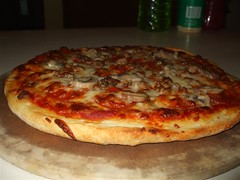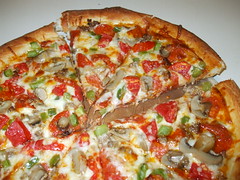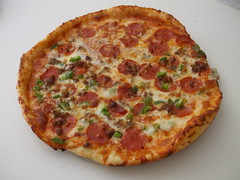Continuing my posts on tools used to make pizza, another type of pan used is a perforated pizza pan. I picked one up on Amazon and gave it a try. Supposedly it allows more heat to reach the pizza than a typical solid pan, but not as much as a pizza stone which allows for great heat conduction and moisture loss due to its porous nature. Many small holes or fewer larger holes in the pan will allow more moisture to escape. This means that the bottom of the crust will become crispy. Depending on whether you like crispy crust, this may or may not appeal to you. I can be wary about thin crispy crusts; I don’t like ones that are so thin they have no taste or are too tough or chewy. I can imagine that it’s easy to overcook the crust if you have too many holes in the pan.
Pizza Screens
Another type of pan is a pizza screen (left). While the perforated pan has larger holes, the pizza screen will have tons of smaller holes without much space between them. I believe the larger holes allow more moisture to leave, resulting in a crisper crust than the screen (even though the screen has more holes). I haven’t used a screen yet to find out. I believe you can also use special screens directly on a grill to cook your pizza. We have one but haven’t tried it out yet either.
Anti-stick Agent
I used shortening on the perforated pan to make sure the pizza did not stick. Just used a paper towel to spread it around. I was afraid using olive oil would be messy and wasteful as it flows out of the holes! Of course a spray can with olive oil would be the next logical idea. Shortening was also messy — you’ll definitely need to clean up afterwards! I like the taste of oil-cooked pizzas from restaurants, but I haven’t mastered the technique yet. I tried it in my deep-dish or regular pan, and it adds a little too much moisture rather than adding to the flavor.
Results
I cooked with my perforated pan a few months ago and here is a picture. The crust wasn’t too bad, and you can see I don’t usually go for thin crust pizzas 🙂 Click the picture to see more on my Flickr account.


